Mehrdad Sabetzadeh
Measuring Improvement of F$_1$-Scores in Detection of Self-Admitted Technical Debt
Mar 16, 2023
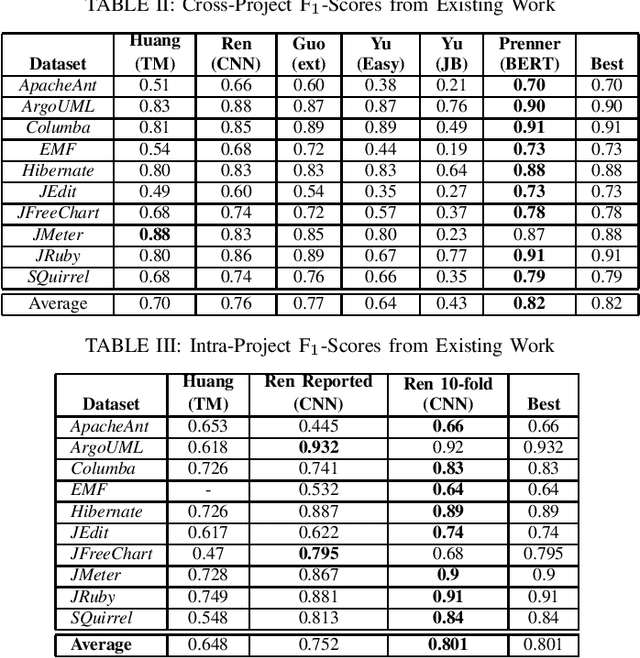
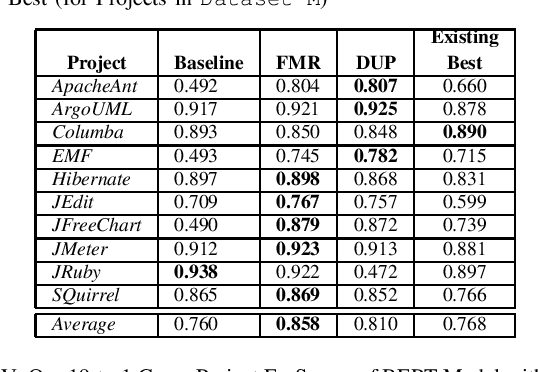
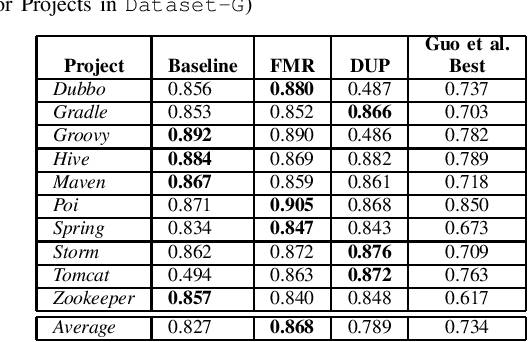
Abstract:Artificial Intelligence and Machine Learning have witnessed rapid, significant improvements in Natural Language Processing (NLP) tasks. Utilizing Deep Learning, researchers have taken advantage of repository comments in Software Engineering to produce accurate methods for detecting Self-Admitted Technical Debt (SATD) from 20 open-source Java projects' code. In this work, we improve SATD detection with a novel approach that leverages the Bidirectional Encoder Representations from Transformers (BERT) architecture. For comparison, we re-evaluated previous deep learning methods and applied stratified 10-fold cross-validation to report reliable F$_1$-scores. We examine our model in both cross-project and intra-project contexts. For each context, we use re-sampling and duplication as augmentation strategies to account for data imbalance. We find that our trained BERT model improves over the best performance of all previous methods in 19 of the 20 projects in cross-project scenarios. However, the data augmentation techniques were not sufficient to overcome the lack of data present in the intra-project scenarios, and existing methods still perform better. Future research will look into ways to diversify SATD datasets in order to maximize the latent power in large BERT models.
TAPHSIR: Towards AnaPHoric Ambiguity Detection and ReSolution In Requirements
Jun 21, 2022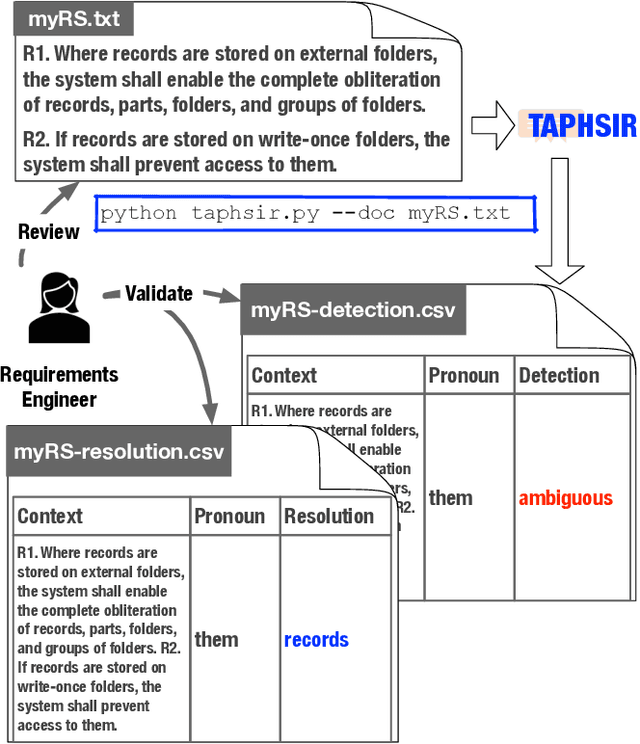
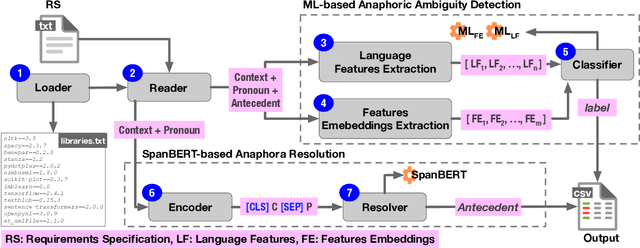
Abstract:We introduce TAPHSIR, a tool for anaphoric ambiguity detection and anaphora resolution in requirements. TAPHSIR facilities reviewing the use of pronouns in a requirements specification and revising those pronouns that can lead to misunderstandings during the development process. To this end, TAPHSIR detects the requirements which have potential anaphoric ambiguity and further attempts interpreting anaphora occurrences automatically. TAPHSIR employs a hybrid solution composed of an ambiguity detection solution based on machine learning and an anaphora resolution solution based on a variant of the BERT language model. Given a requirements specification, TAPHSIR decides for each pronoun occurrence in the specification whether the pronoun is ambiguous or unambiguous, and further provides an automatic interpretation for the pronoun. The output generated by TAPHSIR can be easily reviewed and validated by requirements engineers. TAPHSIR is publicly available on Zenodo (DOI: 10.5281/zenodo.5902117).
AI-enabled Automation for Completeness Checking of Privacy Policies
Jun 10, 2021



Abstract:Technological advances in information sharing have raised concerns about data protection. Privacy policies contain privacy-related requirements about how the personal data of individuals will be handled by an organization or a software system (e.g., a web service or an app). In Europe, privacy policies are subject to compliance with the General Data Protection Regulation (GDPR). A prerequisite for GDPR compliance checking is to verify whether the content of a privacy policy is complete according to the provisions of GDPR. Incomplete privacy policies might result in large fines on violating organization as well as incomplete privacy-related software specifications. Manual completeness checking is both time-consuming and error-prone. In this paper, we propose AI-based automation for the completeness checking of privacy policies. Through systematic qualitative methods, we first build two artifacts to characterize the privacy-related provisions of GDPR, namely a conceptual model and a set of completeness criteria. Then, we develop an automated solution on top of these artifacts by leveraging a combination of natural language processing and supervised machine learning. Specifically, we identify the GDPR-relevant information content in privacy policies and subsequently check them against the completeness criteria. To evaluate our approach, we collected 234 real privacy policies from the fund industry. Over a set of 48 unseen privacy policies, our approach detected 300 of the total of 334 violations of some completeness criteria correctly, while producing 23 false positives. The approach thus has a precision of 92.9% and recall of 89.8%. Compared to a baseline that applies keyword search only, our approach results in an improvement of 24.5% in precision and 38% in recall.
On Systematically Building a Controlled Natural Language for Functional Requirements
May 04, 2020



Abstract:[Context] Natural language (NL) is pervasive in software requirements specifications (SRSs). However, despite its popularity and widespread use, NL is highly prone to quality issues such as vagueness, ambiguity, and incompleteness. Controlled natural languages (CNLs) have been proposed as a way to prevent quality problems in requirements documents, while maintaining the flexibility to write and communicate requirements in an intuitive and universally understood manner. [Objective] In collaboration with an industrial partner from the financial domain, we systematically develop and evaluate a CNL, named Rimay, intended at helping analysts write functional requirements. [Method] We rely on Grounded Theory for building Rimay and follow well-known guidelines for conducting and reporting industrial case study research. [Results] Our main contributions are: (1) a qualitative methodology to systematically define a CNL for functional requirements; this methodology is general and applicable to information systems beyond the financial domain, (2) a CNL grammar to represent functional requirements; this grammar is derived from our experience in the financial domain, but should be applicable, possibly with adaptations, to other information-system domains, and (3) an empirical evaluation of our CNL (Rimay) through an industrial case study. Our contributions draw on 15 representative SRSs, collectively containing 3215 NL requirements statements from the financial domain. [Conclusion] Our evaluation shows that Rimay is expressive enough to capture, on average, 88% (405 out of 460) of the NL requirements statements in four previously unseen SRSs from the financial domain.
 Add to Chrome
Add to Chrome Add to Firefox
Add to Firefox Add to Edge
Add to Edge